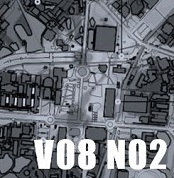Abstract
Although there are many studies about the relationship between urban and architectural form, and the occurrence of crimes, studies that deal specifically with university environments are still rare. In this work, we analyze two pairs of parking lots on the main campus of the Federal University of Santa Catarina (UFSC), in Florianópolis, to ascertain if visibility, permeability, number of users and land use diversity are relevant explanatory factors of higher or lower quantities of crime occurrences in these areas. Each pair comprised one parking lot with high and other with low crime rate, both with similar amounts of parking spots. Field surveys, observations, and maps supported a comparative analysis. The results indicate that visibility and permeability are effectively crucial in reducing the occurrence of crimes. On the other hand, the sheer number of people in each place was not able to explain the differences in crime rates, except when its distribution throughout the day and the visibility provided by the primary circulation paths to the parking lots were taken into account. As for land uses, the results were contrary to the widespread belief among architects and urbanists that greater diversity is related to a lower number of criminal occurrences. The conclusions bring forth essential aspects to be considered in debates, masterplans and spatial interventions on university campuses.
References
BONDARUK, Roberson Luiz. A Prevenção do crime através do desenho urbano. 2. ed. Curitiba: Edição do autor, 2007.
CALDEIRA, T. Cidade de muros: Crime, segregação e cidadania em São Paulo. São Paulo: USP, 2000.
CLARKE, R.; CORNISH, D. B. Modeling offenders’ decisions: a framework for research and policy. In: ANDRESEN, M. A.; BRANTINGHAM, P. J.; KINNEY, J. B. (Eds.). Classics in Environmental Criminology. Hoboken: CRC Press, 2010 [1985]. p. 311–340.
COHEN, L. E.; FELSON, M. Social Change and Crime Rate Trends: A Routine Activity Approach. In: ANDRESEN, M. A.; BRANTINGHAM, P. J.; KINNEY, J. B. (Eds.). Classics in Environmental Criminology. Hoboken: CRC Press, 2010 [1979]. p. 187–216.
COZENS, Paul Michael; SAVILLE, Greg; HILLIER, David. Crime prevention through environmental design (CPTED): a review and modern bibliography. Property Management, v. 23, n. 5, p.328-356, 2005. ISSN 0263-7472 https://doi.org/10.1108/02637470510631483
HILLIER, B. et al. Natural movement: or, configuration and attraction in urban pedestrian movement. Environment and Planning B: Planning and Design, v. 20, n. 1, p. 29–66, 1993. ISSN 2399-8083. https://doi.org/10.1068/b200029
JACOBS, Jane. Morte e vida de grandes cidades. São Paulo: Martins Fontes, 2001. (publicado originalmente em 1961 com o título: Life and Death of Great American Cities).
NEWMAN, Oscar. Defensible Space. Crime Prevention Through Urban Design. New York: Collier Books/Macmillan Publishing Co., Inc., 2. ed. 1976.
NEWMAN, Oscar. Personal email to Stephen Town, Police Architectural Liaison Officer, Bradford District, dez.2003.
QUINTANA, Efreu Brignol. Influência de características físico-espaciais na ocorrência de crimes e na percepção de segurança em áreas residenciais com condomínios fechados. 2013. 290f.. Dissertação (Mestrado em Arquitetura e Urbanismo) - Programa de Pós-Graduação em Planejamento Urbano e Regional, Universidade Federal do Rio Grande do Sul, Porto Alegre.
SABOYA, Renato Tibiriçá de; BANKI, Gabriela Hall; SANTANA, Júlia Mayer Alves de. Uso do solo, visibilidade e ocorrência de crimes: um estudo de caso em Florianópolis, Santa Catarina. Oculum ens., Campinas, 13(2), 255-274, Julho-Dezembro 2016. ISSNe 2318-0919. https://doi.org/10.24220/2318-0919v13n2a2990
SORENSEN, David. The nature and prevention of residential burglary: A review of the international literature with an eye towards prevention in Denmark. 2003. Disponível em: http://www.justitsministerietdk/sites/default/files/media/Arbejdsomraader/Forskning/Forskningspuljen/2011/2003/The_Nature_and_Prevention_of_Residential_Burglary.pdf. Acesso em: 15 jun. 2015.
VIVAN, Mariana. Arquitetura, espaço urbano e criminalidade: relações entre o espaço construído e a segurança sob a ótica da intervisibilidade. 2012. 191f.. Dissertação (Mestrado em Arquitetura e Urbanismo) - Programa de Pós-Graduação em Arquitetura e Urbanismo, Universidade Federal de Santa Catarina, Florianópolis.
WILCOX, Pamela; LAND, Kenneth C.; HUNT, Scott A. Criminal circumstance: a dynamic multicontextual criminal opportunity theory. Rev. ed. New York: Walter de Gruyter, Inc, 2003.
WORTLEY, Richard; MAZEROLLE, Lorraine. Environmental criminology and crime analysis: situating the theory, analytic approach and application. In: WORTLEY, R.; MAZEROLLE, L. G. (Eds.). Environmental criminology and crime analysis. Crime science series. Cullompton, UK: Willan, 2008.
ZANOTTO, Karen da Rosa. Segurança em área urbana central: Configuração, Forma Urbana e Usuários. 2002. 161f.. Dissertação (Mestrado em Arquitetura e Urbanismo) - Programa de Pós-Graduação em Planejamento Urbano e Regional, Universidade Federal do Rio Grande do Sul, Porto Alegre.
I accept that PARC Research in Architecture and Building Construction journal perform, on the original file approved for publication, revisions and modifications in orthoghaphic, grammar and standard issues.
I give to PARC Research in Architecture and Building Construction journal the rights of first publication of the revised version of my paper, licensed under the 'Creative Commons Attribution' license (which allows sharing the work with the recognition of first authorship and publication in this journal).

